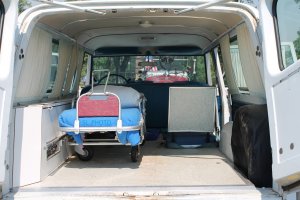...from the Dallas area:
Richardson FD
1974 GMC
Mesquite FD
1975 Chevrolet
A show of hands, please...how many in this group have actually worked out of an ambulance with curtains in it?
(Duane Troxel photos)
Oh yeah, curtains. Just about all of the Superior Caddies carried curtains in our area (Orange and L.A. Counties, CA). A few of our "crash trucks," the local term for Suburban based units, had curtains as well.
During the waning days of the Vietnam War (1973) we periodically responded to the Long beach, CA airport to meet MAC (Military Airlift Command) Flights, composed of the C-9 Nightingale Transport ambulance aircraft (DC-9 civilian model) coming from military hospital units in Hawaii. They brought back the war wounded going for continuing care at the Long Beach VA Hospital.
We'd take our cue from the young military nurses as to which patients to load first and carry them down the long aircraft side ramp to the ambulance on the tarmac. I still think back and remember one nurse in particular. She was beautiful, trim and sharp in her uniform, but her face had that thousand yard stare, like she had just about reached her limit of what she could take. Her uniform was soaked in sweat patches from the long hot trip across the Pacific and she never smiled once, her attention concentrated on the list of her patients, making sure they made it to the correct ambulance.
Our unit carried 4 stretcher patients (2 from ceiling hooks, one on the squad bench and one on the gurney. These guys were devastated physically and emotionally, having received emergency treatment in Hawaii, direct from the battlefield, and coming home for convalescence. Most were quads and paraplegics, lower extremity amputations were common. Almost every one of them was fitted with a "rubber duckie" so we had to be very careful not to burst a bag.
Because of the rat fink war protesters picketing the airport whenever these boys came back home (Cal State Long Beach was nearby), I usually closed the curtains so the guys would not have to endure seeing the angry mobs spitting on the ambulance windows, slapping her upside the quarter panels with their signs and screaming foul language at our patients.
These guys had suffered enough and the flimsy curtains offered at least visual protection for them. We're talking amputees as well, sometimes all extremities (extremely difficult to place on a gurney without throwing our balance off while lifting the old Model-30 Fernos). I didn't want to degrade them by plopping them right in the middle of the gurney, as there were many passengers crowding the airport terminal windows to watch the ambulance action below, so my partner and I sat them up with the head of the cot slightly raised, placed a rolled blanket where the legs would be and covered them from the chest down with a light sheet to disguise their quadruple amputee form. This placed all the weight forward, so we had to be extra careful lifting and loading an unbalanced gurney. My back was a small price to pay, considering these boys no longer had limbs...at least we could down an aspirin and be good to keep on keepin' on.
The MAC Flight job was a solemn thing, it usually was very emotionally hard on the crews as we spent the day meeting plane after plane of broken bodies, young guys about our own ages. You could see the aircraft spread across the blue California sky on final, spaced out 5 miles apart as they turned from base to final approach and landing. You could gauge the workload for the day by counting all the stacked military stretchers at the receiving entrance to the VA neuro unit.
For ambulance buffs, seeing all those 1970s era ambulances at one place on a sunny day was an awesome thing. There'd be a line of ambulances all around the perimeter of the airport, you'd see Schaefer's, Goodhew, Seal's, Wind, Southland and just about the whole of Southern California ambulance services fielding units to handle the incoming wounded. It was a solemn thing, but the sight of the colorful pro cars all lined up in one place was certainly something to behold.
The Caddies and crash trucks benefited most from curtains, and although I seldom used them, they came in real handy on these calls.







